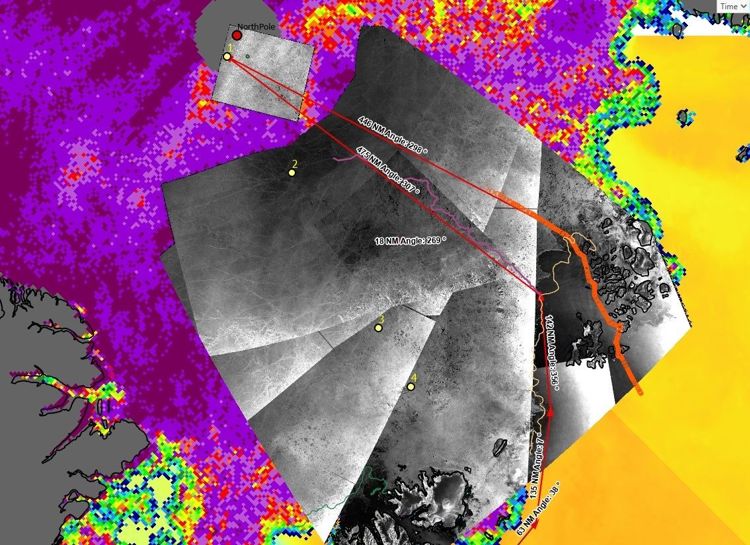Picture: Captain Geir-Magne Leinebø and CAATEX expedition leader Dr. Hanne Sagen at the North Pole on Wednesday. Credit: Norwegian Coast Guard
This week marked a new chapter in Norwegian polar history as KV Svalbard reached the North Pole on Wednesday morning. The ship sails on a mission from the Nansen Centre in Bergen. Onboard scientists from all over the world will use audio signals to map the sea temperature across the entire Arctic Ocean, as part of CAATEX - an ocean climate change research project.
KSAT supports the expedition through daily deliveries of satellite images, showing in detail the updated ice situation. Fresh satellite images and ice charts has made it possible to update the voyage plan continuously thus enabling KV Svalbard to find the best route through the ice.
«The northern waters in which our Coast Guard vessels operate are very demanding. It is not only the climate that challenges us, but also lack of sensor coverage. It is therefore important to get updated information and data from KSAT in order to both be able to plan and execute safe missions, as well as to get an overview of which vessels are in the area» - says Lieutenant Colonel Ivar Moen from The Norwegian Joint Headquarters (NJHQ).
A recent example of where satellite data had been very useful in a rescue operation is from January this year when the Northguider, a fishing vessel, ran aground in the Hinlopen Strait, northeast of Svalbard. Severe cold, challenging waters and the remote location made the rescue operation extremely challenging. KSAT supported the Norwegian Coastal Administration with satellite images and updated information on the exact position of the vessel.
Former Naval captain Andreas Kjøl, now senior engineer at the Norwegian Coastal Administration, was on board when KV Svalbard reached the North Pole:
«The experience from the Northguider campaign was that updated satellite imagery from KSAT, where the delivery chain was tailored to low bandwith, would also be very useful for monitoring the ice conditions supporting all vessels navigating in Arctic regions. The Norwegian Coastal Administration and KV Svalbard have therefore used satellite images from KSAT on a daily basis during the CAATEX expedition on the way to the North Pole».
Rolf Skatteboe, President and CEO of KSAT is very pleased that satellite-based information from KSAT plays a key role in this historic event;
«I am happy to hear that KV Svalbard has reached the North Pole and that they have benefited from our satellite data along the way. Satellite based information is an important component for safety and preparedness in the north. By satellite monitoring the Arctic waters on a regular basis we can detect irregularities related to fisheries or acute pollution at an early stage.
Access to up-to-date information on ice and ice movements on-board vessels, which has been done here, contributes to safe operations in the north. By having a regular monitoring in place, as we do for the Norwegian coast and the Norwegian continental shelf, we are ready to assist quickly in emergency situations, as we did in the Hinlopen Strait».

This gaphic includes the following SAR images:
- Sentinel-1 © Copernicus 2019
- RADARSAT-2 Data and Products © Maxar Technologies Ltd. (2019) – All Rights Reserved. RADARSAT is an official mark of the Canadian Space Agency
- COSMO-SkyMed © ASI 2019 processed under license from ASI - Agenzia Spaziale Italiana, All rights reserved. Distributed by e-GEOS/FMI
Both RADARSAT-2 and COSMO-SkyMed images have been provided through the Copernicus Marine Environment Monitoring Service (CMEMS) http://marine.copernicus.eu/
